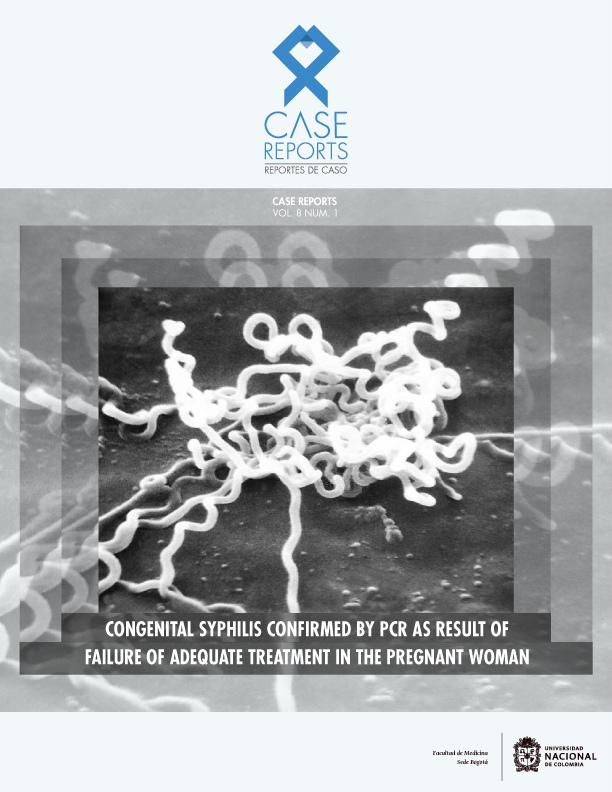Congenital syphilis. New questions about a neglected but re-emerging condition
Sífilis congénita. Surgimiento de nuevos interrogantes ante una condición olvidada pero reemergente
DOI:
https://doi.org/10.15446/cr.v8n1.99963Palabras clave:
Syphilis Congenital, Treatment Failure, Penicillin G Benzathine, Syphilis Serodiagnosis, Polymerase Chain Reaction, Nephritis (en)Sífilis congénita, Insuficiencia del tratamiento, Penicilina G benzatina, Serodiagnóstico de la sífilis, Reacción en cadena de la polimerasa, Nefritis (es)
Descargas
In this issue of Case Reports, Cifuentes-Cifuentes et al. (1) describe a case of congenital syphilis (CS) in a newborn resulting from the first pregnancy of a woman who, despite having been diagnosed with syphilis through serological tests four years earlier, had not received treatment.
En el presente número de la Revista Case Reports, Cifuentes-Cifuentes et al. (1) presentan un caso de sífilis congénita (SC) en un recién nacido producto del primer embarazo de una mujer quien, a pesar de haber sido diagnosticada con sífilis cuatro años atrás mediante pruebas serológicas, no había recibido tratamiento.
https://doi.org/10.15446/cr.v8n1.99963
Congenital syphilis. New questions about a neglected but re-emerging condition
Keywords: Syphilis, Congenital; Treatment Failure; Penicillin G Benzathine; Syphilis Serodiagnosis; Polymerase Chain Reaction; Nephritis.
Palabras clave: Sífilis congénita; Insuficiencia del tratamiento; Penicilina G benzatina; Serodiagnóstico de la sífilis; Reacción en cadena de la polimerasa; Nefritis.
Hernando Gaitán-Duarte
Universidad Nacional de Colombia
- Bogotá Campus- Faculty of Medicine -
Department of Obstetrics and Gynecology
- Bogotá- Colombia.
Corresponding author
Hernando Gaitán Duarte. Departamento de Obstetricia y Ginecología, Facultad de Medicina, Universidad Nacional de Colombia. Bogotá D.C. Colombia.
Email: hggaitand@unal.edu.co
Received: 29/11/2021 Accepted: 06/12/2021
In this issue of Case Reports, Cifuentes-Cifuentes et al. (1) describe a case of congenital syphilis (CS) in a newborn resulting from the first pregnancy of a woman who, despite having been diagnosed with syphilis through serological tests four years earlier, had not received treatment.
At 21 weeks pregnant, the mother attended a prenatal check-up where she was ordered a VDRL test that showed a 1:4 dilution, as well as a treponemal test that was positive. Therefore, she was diagnosed with gestational syphilis (GS) and was prescribed a weekly dose of 2 400 000 IU of benzathine penicillin for 3 weeks.
At the time of delivery, both the mother and the newborn underwent a VDRL test, and although the mother had a 1:1 dilution, which was interpreted as a satisfactory response to treatment, the result in the newborn was a 1:4 dilution. Since the infant also had elevated liver enzyme levels and his urinalysis showed signs of renal failure, he was considered to be a case of CS. Treatment was started with 150 000 IU of intravenous crystalline penicillin every 12 hours for 10 days, which resulted in improvement of the signs of renal failure and liver disease, as well as a negative VDRL test result at 3 months.
This case presents relevant and novel information about the management of CS since Cifuentes-Cifuentes et al. (1) concluded that the recommended treatment for GS was insufficient to prevent CS. Consequently, they indicated that clinical and serological follow-up is required to confirm whether maternal treatment was effective in the fetus.
Given the relevance of this publication, I would like to make some reflections that could explain the failure to treat CS when treating GS.
Possible maternal re-infection within 30 days prior to delivery
According to the case report, the pregnancy occurred in a woman with late latent syphilis, who became pregnant as a result of a consensual relationship that lasted 3 months; however, it is unclear whether or not the patient had sexual intercourse with this or another partner after the administration of the therapeutic regimen given to her at week 22 of gestation based on the stage of her infection. Thus, reinfection in the mother (primary syphilis) cannot be ruled out as a cause of CS, especially if it was acquired within 30 days after delivery and had little effect on the maternal serological test (2,3). Data about a new sexual contact may not be presented because the patient was not asked for it, or she did not respond or answered incorrectly. In other words, this case report neither confirms nor denies this possibility.
It is important to keep in mind that, as described in Cifuentes-Cifuentes et al. (1), international guidelines do not consider the administration of benzathine penicillin to the mother as effective for the treatment of GS if it is administered 30 days before delivery, which is consistent with what has been reported in the literature (2,3).
Undertreatment of CS
According to Workowski et al. (2), a single dose of 2 400 000 IU of benzathine penicillin is effective in curing 97% of CS cases if administered more than 30 days before delivery and if there is no reinfection. Therefore, the case of Cifuentes-Cifuentes et al. (1) could be among the 3% of patients who do not respond to treatment or could be a case of decreased response of fetal Treponema pallidum to benzathine penicillin administered to the mother. However, this cannot be validated because the evidence supporting the effectiveness of GS treatment in terms of fetal or neonatal outcome is considered to be of low certainty since the majority of the information is derived from observational studies (4).
In this regard, in the case published by Cifuentes-Cifuentes et al. (1), more than explaining reinfection, the mechanism that would explain the success of treatment in the mother but the failure of treatment in the fetus remains unclear.
Another interesting aspect of the case presented by Cifuentes-Cifuentes et al. (1) is that infection in the newborn was confirmed by a polymerase chain reaction (PCR) test to detect T. pallidum, which is one of the most sensitive and specific diagnostic tests to identify this bacterium (2). This is relevant because the diagnosis of syphilis is still based on treponemal and non-treponemal tests, as diagnosis and treatment in a single time have been prioritized for both pregnant women and high-risk populations (5); however, these tests do not perform well in primary syphilis, where microscopy techniques of genital or oral ulcer samples are preferred (2). It is worth mentioning that a very interesting application of PCR tests is that they detect strains resistant to macrolides (2) or tetracyclines (3).
In summary, this case report raises several problems that should be addressed by researchers and public health agencies regarding syphilis infection in Colombia:
For researches, different questions arise, such as: what is the effectiveness, in terms of fetal outcomes, of crystalline penicillin compared with benzathine penicillin in the treatment of CS when detected within 30 days prior to delivery?; what is the resistance profile of T. pallidum to macrolides and tetracyclines in Colombia?; and what is the effectiveness of therapeutic alternatives for syphilis in case of penicillin resistance or shortage of this drug?
In turn, health authorities should consider whether it would be important to know the magnitude of the syphilis problem in the general population of the country, given that surveillance reports published by the Ministry of Health and Social Protection of Colombia indicate that the prevalence rate of gestational syphilis is 1.3 cases per 100 live newborns (2). This would allow determining if there is an undeclared epidemic of population-based syphilis, what measures are being taken to control syphilis outbreaks in the general population, and what surveillance methods are being implemented for dealing with antibiotic-resistant T. pallidum.
The situation of GS and CS in Colombia may be a warning sign of the syphilis situation in the general population; therefore, it must be viewed as a public health issue, as the disease cannot be eradicated if the foci of infection are not controlled. In this sense, the researchers must work to ensure that the entities responsible for its prevention, treatment, follow-up and control, both individual and collective, provide the necessary resources to seek solutions that enable an interdisciplinary approach to care for patients with syphilis and to generate strategies to prevent and eradicate this infection.
References
1.Cifuentes-Cifuentes Y, Gómez-Aristizábal LS, Pinilla G, Cruz C, Navarrete J. Congenital syphilis confirmed by PCR as result of failure of adequate treatment in the pregnant woman. Case report. Case Reports. 2021;7(2). https://doi.org/10.15446/cr.v7n2.91044.
2.Workowski KA, Bachmann LH, Chan PA, Johnston CM, Muzny CA, Park I, et al. Sexually Transmitted Infections Treatment Guidelines, 2021. MMWR Recomm Rep. 2021;70(4):1-187. https://doi.org/gm4ftd.
3.World Health Organization (WHO). WHO Guidelines for the Treatment of Treponema pallidum (syphilis). Geneva: WHO; 2016 [cited 2022 Apr 4]. Available from: https://bit.ly/3pxVWZK.
4.Blencowe H, Cousens S, Kamb M, Berman S, Lawn JE. Lives Saved Tool supplement detection and treatment of syphilis in pregnancy to reduce syphilis related stillbirths and neonatal mortality. BMC Public Health. 2011;11(Suppl 3):S9. https://doi.org/c79w8j.
5.Tsimis ME, Sheffield JS. Update on syphilis and pregnancy. Birth Defects Res. 2017;109(5):347-52. https://doi.org/f92wfv.
Referencias
Cifuentes-Cifuentes Y, Gómez-Aristizábal LS, Pinilla G, Cruz C, Navarrete J. Congenital syphilis confirmed by PCR as result of failure of adequate treatment in the pregnant woman. Case report. Case Reports. 2021;7(2). https://doi.org/10.15446/cr.v7n2.91044.
Workowski KA, Bachmann LH, Chan PA, Johnston CM, Muzny CA, Park I, et al. Sexually Transmitted Infections Treatment Guidelines, 2021. MMWR Recomm Rep. 2021;70(4):1-187. https://doi.org/gm4ftd. DOI: https://doi.org/10.15585/mmwr.rr7004a1
World Health Organization (WHO). WHO Guidelines for the Treatment of Treponema pallidum (syphilis). Geneva: WHO; 2016 [cited 2022 Apr 4]. Available from: https://bit.ly/3pxVWZK.
Blencowe H, Cousens S, Kamb M, Berman S, Lawn JE. Lives Saved Tool supplement detection and treatment of syphilis in pregnancy to reduce syphilis related stillbirths and neonatal mortality. BMC Public Health. 2011;11(Suppl 3):S9. https://doi.org/c79w8j. DOI: https://doi.org/10.1186/1471-2458-11-S3-S9
Tsimis ME, Sheffield JS. Update on syphilis and pregnancy. Birth Defects Res. 2017;109(5):347-52. https://doi.org/f92wfv. DOI: https://doi.org/10.1002/bdra.23562
Cómo citar
APA
ACM
ACS
ABNT
Chicago
Harvard
IEEE
MLA
Turabian
Vancouver
Descargar cita
Licencia

Esta obra está bajo una licencia internacional Creative Commons Atribución 4.0.
Los autores al someter sus manuscritos aceptan transferir a Case reports los derechos de autor de los artículos publicados. La editorial tiene el derecho del uso, reproducción, transmisión, distribución y publicación en cualquier forma o medio. Los autores no podrán permitir o autorizar el uso de la contribución sin el consentimiento escrito de la revista.
Formulario de Divulgación Uniforme para posibles Conflictos de Interés, los oficios de cesión de derechos y de responsabilidad deben ser entregadas junto con el original.
Aquellos autores/as que tengan publicaciones con esta revista, aceptan los términos siguientes:
Los autores/as conservarán sus derechos de autor y garantizarán a la revista el derecho de primera publicación de su obra, el cual estará simultáneamente sujeto a la Licencia de reconocimiento de Creative Commons que permite a terceros compartir la obra siempre que se indique su autor y su primera publicación esta revista.
Los autores/as podrán adoptar otros acuerdos de licencia no exclusiva de distribución de la versión de la obra publicada (p. ej.: depositarla en un archivo telemático institucional o publicarla en un volumen monográfico) siempre que se indique la publicación inicial en esta revista.
Se permite y recomienda a los autores/as difundir su obra a través de Internet (p. ej.: en archivos telemáticos institucionales o en su página web) antes y durante el proceso de envío, lo cual puede producir intercambios interesantes y aumentar las citas de la obra publicada. (Véase El efecto del acceso abierto).































